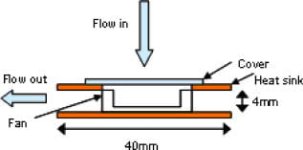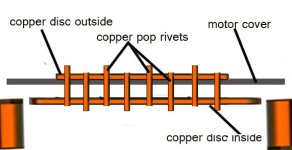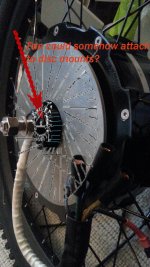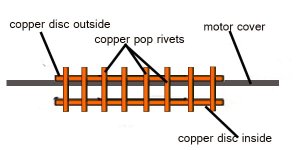You are using an out of date browser. It may not display this or other websites correctly.
You should upgrade or use an alternative browser.
You should upgrade or use an alternative browser.
Definitive Tests on the Heating and Cooling of Hub Motors
- Thread starter justin_le
- Start date
richdeloup
100 W

These are meant for small appliances, so not sure if of use for us lot?
The results show a good thermal performance and highlight the need to develop the heat sink and fan as an integrated thermal solution rather than in isolation as is the traditional methodology. An interesting finding is that the heat transfer scales are in line with turbulent rather than laminar correlations despite the low Reynolds number.
Sounds impressive even if not fully understood
I cant see anywhere possible to fit an electric fan but maybe well designed fins and a low profile heatsink as in the diagram may work?
It means that turbulent (swirly) airflow cools better than laminar (smooth). The Reynolds number simply describes how turbulent the flow is (or not) and you'd want to be several thousands to ensure turbulent flow. It's not really relevant though. It's easy to calculate the Reynolds number in something like a pipe, but inside the complicated shape of a hubmotor interior would be more difficult. It's also much easier to get turbulent flow than laminar.
Just make sure the airflow is high
Just make sure the airflow is high
richdeloup
100 W
Thanks that explains it!
I was really just looking for the best design on a simple lightweight CNC'd cover for use on an oil cooled motor.
I was really just looking for the best design on a simple lightweight CNC'd cover for use on an oil cooled motor.
richdeloup
100 W
richdeloup
100 W

Edit; to keep with the title of the thread, ill test with standard motor, then oil cooled, then no oil but with above riveted on, then with both. I'm not tech enough to draw graphs but will take the same varied terrain route and video the temp gauge and timer to try to figure out whats going on.....
John Bozi
100 kW
are rivets leak proof? wouldn't it be easier to just epoxy on fins to the outside cover and then hope that one day in a crash that the spinning wheel doesn't rip through somebodies flesh?
What's the weight of the oil and and extra proposed metal added?
If it is significant then adding more weight is also adding more heat to get the same speed...
A light secondary motor to keep the bike moving might be a solution. The weight is a big thing I need to spend time considering before I decide to stay with dual motor set up or not. It's really pointless unless you are in the overheat zone quite a bit as I am up the mountains...
[youtube]L8KJdV4IedQ[/youtube]
What's the weight of the oil and and extra proposed metal added?
If it is significant then adding more weight is also adding more heat to get the same speed...
A light secondary motor to keep the bike moving might be a solution. The weight is a big thing I need to spend time considering before I decide to stay with dual motor set up or not. It's really pointless unless you are in the overheat zone quite a bit as I am up the mountains...
[youtube]L8KJdV4IedQ[/youtube]
richdeloup
100 W
Good point, I'm using rivets at the moment and of the 8 on there only two are leaking (part sealed with high temp silicone). There are open ended rivets which I'm using at the moment but also closed ended which ill try out next... Also with a load of copper rivets protruding, im figuring that braising fins onto them may be easier than aluminium welding and that they may provide the thermal flow to the exterior?. ye safety wise, well we can figure that out laterare rivets leak proof? wouldn't it be easier to just epoxy on fins to the outside cover and then hope that one day in a crash that the spinning wheel doesn't rip through somebodies flesh?
100ml seems to be the optimum and i'm going for 2mm thick copper discs, more about surface area than density; ill weigh it all once made up.What's the weight of the oil and and extra proposed metal added?
wine=edits
Someone in the UK must have brought in a ship load of 9c copies which they are trying to get rid of, as they are super cheap on ebay. So a good opportunity to get them in the overheat zone to analyse what works and what doesnt
They actually have 250w stamped on them!
I think I get what you're saying about if adding extra weight, then why not just get a more capable motor of the same weight and stay out of the danger zone, but where do you stop maxing out? im thinking that we are still a long way off the 600miles a day at full speed motorbike world, which one day i hope we'll get to.
richdeloup
100 W
Twin drive vid, cool, i've been thinking about that, but there is always someone whose already done it on here; so when one motor overheats you switch?
John Bozi
100 kW
richdeloup said:Twin drive vid, cool, i've been thinking about that, but there is always someone whose already done it on here; so when one motor overheats you switch?
In an ideal world the two motors at the same power level would be great, but realistically a mid drive cant run the same power through the hub drive train. So the main hub stays the same but has the much smaller motor there to pull it in granny gear for a cool off period, before or after a steep overheating section.
sometimes used at the same time if incredibly steep where the hub bogs to 10kmh.
I also use the mid for all 0-10kmh stuff, but its not perfect, you do need to put some weight on the pedal so that the mid doesn't clack into tension.
Only time will tell, for me now after only one propper long off road ride, it feels too heavy. The extra weight of the motor wasting more power and creating more heat that it then compensates for.....
the snake eating its tail.
John in CR
100 TW
richdeloup said:Twin drive vid, cool, i've been thinking about that, but there is always someone whose already done it on here; so when one motor overheats you switch?
It's more twice as good to run both at the same time. Assuming they're equal it's half the current to each, which creates half the heat to begin with, and then you have twice the heat dissipation. Half the heat and twice the cooling means you can significantly increase performance and still come out way way ahead.
John Bozi
100 kW
John in CR said:richdeloup said:Twin drive vid, cool, i've been thinking about that, but there is always someone whose already done it on here; so when one motor overheats you switch?
It's more twice as good to run both at the same time. Assuming they're equal it's half the current to each, which creates half the heat to begin with, and then you have twice the heat dissipation. Half the heat and twice the cooling means you can significantly increase performance and still come out way way ahead.
It just isn't going to happen unless I dunb down the hub to run at the mid drive power levels. The problem is that you can't shift gears anywhere near the way say the hub ramps from 0-50kmh.
sure on a long section where the road stays the same steepness, but not on complex up and down sections I see on my firetrails. Having to power off to change gear is a big pain too.
I am interested in ebikes.ca new splined hub motorm no idea of it's strength to run a mid through but it would be my choice so that I could have a choice of modern cassettes which should shift just as well as a mountain bike does. These 7 speed freewheels never seem to be spaced properly or just I am lousy at getting them to shift properly.... I only have a bout 3 speeds that are clean usable...
richdeloup
100 W
Ive done a few tests over the Christmas period without the heat transfer idea that I want to try out. I'm sure this oil cooled bit has been covered before in more detail, but running at 100v 60A on a 9c clone.
Standard motor not modded Overheat (90 degrees) 8.12 minutes
Oil cooled with 100ml ATF Overheat (90 degrees) 10.14 minutes
Oil cooled with 200ml ATF Overheat (90 degrees) 19.34 minutes
Same 1 mile route, varied terrain on road/ off road.
I thought that 100ml ATF was thought to be the optimum amount? I suppose any extra AFT takes longer to heat up, anyhow now for some copper rivets along the lines below, to try to get the heat out. Thinking more rivets may add more surface area than a copper disc but will try both ideas....
Standard motor not modded Overheat (90 degrees) 8.12 minutes
Oil cooled with 100ml ATF Overheat (90 degrees) 10.14 minutes
Oil cooled with 200ml ATF Overheat (90 degrees) 19.34 minutes
Same 1 mile route, varied terrain on road/ off road.
I thought that 100ml ATF was thought to be the optimum amount? I suppose any extra AFT takes longer to heat up, anyhow now for some copper rivets along the lines below, to try to get the heat out. Thinking more rivets may add more surface area than a copper disc but will try both ideas....
izeman
1 GW
The extra oil will not delay heat up because of it's mass/volume but because it can cover the windings better and transport more heat away from them to the covers.
richdeloup
100 W
Great thanks, I was wondering if this was the case but as I read that 100ml was a good amount to use, I though that this would be enough to cover the winding. Each motor is obviously a different size;
the motor I'm using is pretty small with just a 30mm wide stator but obviously needs more than 100ml.
the motor I'm using is pretty small with just a 30mm wide stator but obviously needs more than 100ml.
itchynackers
100 kW
No one ever said 100mL was optimal. Its just what people were comfortable using (not sure why). It somehow morphed into gospel. FWIW, I was using 600mL running up Pikes. This is half the total capacity of my 9c motor. The more you use, the more risk of leakage out the axle (per my empirical data).
izeman
1 GW
ppl added oil and tested no load current. there was a point where adding more oil leaded to higher amps. that's where they stopped saying it was the optimal fill. not saying that more oil can/can't cool the motor better. and the limit is the height of the breather hole. if you fill the motor beyond that point it will leak all the time. 
richdeloup
100 W
As said, I suppose a lot of people were talking about the optimal balance level between cooling, higher amp draw and every day hassle factor, good to know
Think ill stay at 200ml as I'm more interested in trying to get the heat out of the oil once it's max'd out....
Think ill stay at 200ml as I'm more interested in trying to get the heat out of the oil once it's max'd out....
itchynackers
100 kW
izeman said:ppl added oil and tested no load current. there was a point where adding more oil leaded to higher amps. that's where they stopped saying it was the optimal fill. not saying that more oil can/can't cool the motor better. and the limit is the height of the breather hole. if you fill the motor beyond that point it will leak all the time.
This is [strike]somewhat[/strike] very misleading, and part of reason ppl are stuck on the 100 ml. In fact, adding the first 100ml will add the MOST resistance (no load). The fluid added beyond that first 100 ml does very little to increase no load current. You'd probably be surprised how little the no load increases with lots more coolant.
itchynackers
100 kW
Just to add some real data rather than talk, here is some testing I did a while back from this thread...
http://endless-sphere.com/forums/viewtopic.php?f=30&t=38039&hilit=load&start=25
http://endless-sphere.com/forums/viewtopic.php?f=30&t=38039&hilit=load&start=25
itchynackers said:After being the first bike up the Pikes Peak race this year, I can attest that liquid cooling does work. I just completed my winter teardown to make a few improvements. Found out I had a detached capacitor. Who knows how long I was riding like this.
Controller:
Soldered the cap back on after hearing it rattle inside the controller. Not too bad.
Siliconed each cap for vibration resistance.
Snugged the fet screws. They were ALL loose!
Spread more thermal compound on backside of aluminum fet bar.
Installed 12v cooling fan in end cap of controller.
Motor:
Installed new Japanese bearings with thin layer of silicone sealant
Re-sealed interior axle/wire slot with silicone sealant.
Tapped hole in side cover for one way pressure valve like these...
http://www.ebay.com/itm/221106438184?ssPageName=STRK:MEWNX:IT&_trksid=p3984.m1497.l2649
Hopefully this will work a bit better than the "tiny hole" method. I will have to stop and bleed the air once I reach maximum temperature. Hopefully the motor will be in a vacuum state after cooling, which should help avoid leaking fluid.
I bolted everything back up and I'm functional, so I didn't botch the controller, woot!
After charging my 25s 12ah battery to 4.1v/cell, I get the following results:
Edit: Working on filling in the data...
ATF Fluid level Resting V Sagging V No-Load Current Wheel Speed RPM
___________________________________________________________________________
0 ml:................102.5.....102.3............1.29...........46.4.........609.5
50ml:...............102.5.....102.2............1.37...........46.4..........609.5
100ml:..............102.5.....102.1............2.16...........46.0..........604.2
150ml:..............102.5.....102.1............2.24...........45.9..........602.9
200ml:..............102.5.....102.1............2.24...........45.9..........602.9
250ml:..............102.5.....102.1............2.24...........45.9..........602.9
300ml:..............102.5.....102.1............2.24...........45.9..........602.9
350ml:..............102.5.....102.1............2.24...........45.9..........602.9
400ml:..............102.5.....102.0............2.24...........45.9..........602.9
450ml:..............102.5.....102.0............2.24...........45.9..........602.9
500ml:..............102.5.....102.0............2.24...........45.9..........602.9
550ml:..............102.5.....102.0............2.24...........45.9..........602.9
650ml:..............102.5.....102.0............2.25...........45.9..........602.9 (this is exactly half full)
700ml:..............102.5.....102.0............2.31...........45.9..........602.9
Ran out of fluid...
750ml:
800ml:
850ml:
900ml:
950ml:
1000ml:
1050ml:
1100ml:
1150ml:
1200ml:
1250ml:
I measured the total full capacity of the motor at 1300ml using water. I calculated the thermal expansion of atf3 at 0.3% per degree C, so it really doesn't expand too much even with a delta T of 100C. Its the hot air I worry about. If I don't bleed that valve properly, or didn't seal the motor properly, I may have created a pressurized, hot oil filled, spinning electric device that I'm riding at 40mph. What could happen?
richdeloup
100 W
Great information, best buy meself another can of ATF
Emmett
10 kW
Castor oil is better. No foul smell. Easy to clean if it weeps out the breather or axle slot. Way better IMO. 120ml in a H4065.
richdeloup
100 W
Pretty crude mod so far but got bored of riveting. Pretty interesting results which looks like something is working. I ran out of battery so need to retest to see if its a real solution for longer trips or if the extra mass is just taking longer to soak up the heat??
richdeloup
100 W
What I cant figure out is how exactly this is working, any suggestions welcome?
So the internal copper discs runs very close to the windings and should be taking some of the heat either directly or helped by being covered in oil.
Some of the heat should run to the external discs through the copper rivets.
Some of the oil/heat should get traped between the cover and external disc. Maybe because the oil is trapped, it has more time in contact with the cover to transfer the heat through, rather than constantly being on the move? im not really sure, a micro camera would be good to have...
So the internal copper discs runs very close to the windings and should be taking some of the heat either directly or helped by being covered in oil.
Some of the heat should run to the external discs through the copper rivets.
Some of the oil/heat should get traped between the cover and external disc. Maybe because the oil is trapped, it has more time in contact with the cover to transfer the heat through, rather than constantly being on the move? im not really sure, a micro camera would be good to have...
Hi guys, 2 years after starting this thread we're now aiming to wrap up part of the original purpose and intent, which is to have an empirically verified thermal model for not just one specific hub motor, but a general case that we can apply to all the motors on our motor simulator page. I've now got 57 motor types characterized and modeled, or 33 unique motor families if you don't count winding variations of the same hub:

Considering that it generally takes a couple days of setup and experimental tests to measure and exactly fit the motor's thermal characteristics to a model over the full range of RPMs and wind speeds, as was done with a 9C hub in this thread (see http://endless-sphere.com/forums/viewtopic.php?p=718924#p718924 and http://endless-sphere.com/forums/viewtopic.php?p=722948#p722948, there is no way to realistically repeat that for each of these motor. So what I want to do instead is generate a good ballpark set of thermal parameters for a hub based only on easily measured values. Ideally you could feed in the mass of the motor core, the mass of the hub shell, the diameter and width of the casing, and out comes a decent first order guess for the heat conduction coefficients from the core to the shell, and the shell to ambient, as well as the heat capacities both of the Stator core and the shell.
It won't be quite as exact as measuring every single hub individually, but it would be a lot more versatile an approach, especially if as we want to keep adding motors to the simulator database without needing days of testing for each one.

Considering that it generally takes a couple days of setup and experimental tests to measure and exactly fit the motor's thermal characteristics to a model over the full range of RPMs and wind speeds, as was done with a 9C hub in this thread (see http://endless-sphere.com/forums/viewtopic.php?p=718924#p718924 and http://endless-sphere.com/forums/viewtopic.php?p=722948#p722948, there is no way to realistically repeat that for each of these motor. So what I want to do instead is generate a good ballpark set of thermal parameters for a hub based only on easily measured values. Ideally you could feed in the mass of the motor core, the mass of the hub shell, the diameter and width of the casing, and out comes a decent first order guess for the heat conduction coefficients from the core to the shell, and the shell to ambient, as well as the heat capacities both of the Stator core and the shell.
It won't be quite as exact as measuring every single hub individually, but it would be a lot more versatile an approach, especially if as we want to keep adding motors to the simulator database without needing days of testing for each one.
Similar threads
- Replies
- 16
- Views
- 293
- Replies
- 63
- Views
- 4,132
- Replies
- 23
- Views
- 3,347
- Replies
- 19
- Views
- 1,691



